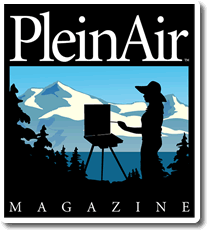Jill Carver: “As an artist, I am in control of how viewers will see my pictures, and the larger the painting, the more important it is that I exercise that control wisely.”
One of the big differences between painting on a small surface outdoors and a large canvas in the studio is the manner in which an artist organizes the shapes, values, colors, and edges, according to Texas artist Jill Carver.
“Design and composition are of utmost importance,” Carver explains. “But there is also the issue of paint quality. In the studio, one has the opportunity to work wet-into-wet or wet-on-dry, and the choice can have a significant impact on the finished painting. Getting up close to a thickly painted Monet or a quickly gestured Sargent is a completely different experience from seeing the same paintings from a distance or in reproduction.
“Also, when comparing the differences between outdoor and studio painting, one has to recognize that there can only be one focal point in a 9 x 12 or 11 x 14-inch painting, whereas a larger studio painting might need several focal points to move the viewer’s attention around. We conducted some experiments at the National Portrait Gallery when I worked at the London museum, and we charted the movements of viewers’ eyes as they looked at the same painting. In almost all cases, people followed similar paths from the main focal point to the other points of interest. And no one failed to take note of the smallest paint accent, creating a tension point within the composition. That was hugely important in making me aware that as an artist, I am in control of how viewers will see my pictures, and the larger the painting, the more important it is that I exercise that control wisely.”
Carver’s education in the United Kingdom predisposed her to be more aware of and influenced by artists who are either little known or not widely respected in the United States. “Because almost every British home had a reproduction of Constable’s 1821 painting ‘Hay Wain’ on the wall,” she says, “and I had the opportunity to see paintings by the Scottish plein air painters known as the Glasgow Boys of the 1880s and 1890s — Joseph Crawhall, Thomas Millie Dow, Sir James Guthrie, George Henry, E.A. Hornell, and E.A. Walton — there was a completely different set of images in my memory than would have been the case if I had grown up in America. Moreover, there was a greater appreciation of abstract painters in Europe than there seems to be in the U.S., and I was very influenced by artists like David Bomberg, Paul Nash, Ivon Hitchens, Peter Lanyon, and John Piper. In my opinion, there is something to be learned from a wide range of artists even if one doesn’t want to emulate their style of work.”
When Carver married her American husband and moved permanently to the United States, she became aware of many of the artists who are heroes to plein air painters in this country. “My friends have made me more aware of the California Impressionists and artists like Serge Bongart,” she says, “and of course I hear the names of John Singer Sargent and Nicholai Fechin mentioned quite frequently. I appreciate knowing more about those great artists, as well as contemporary masters like Skip Whitcomb, Kathryn Stats, and Len Chmiel.”
For more information, visit www.jillcarver.com.




